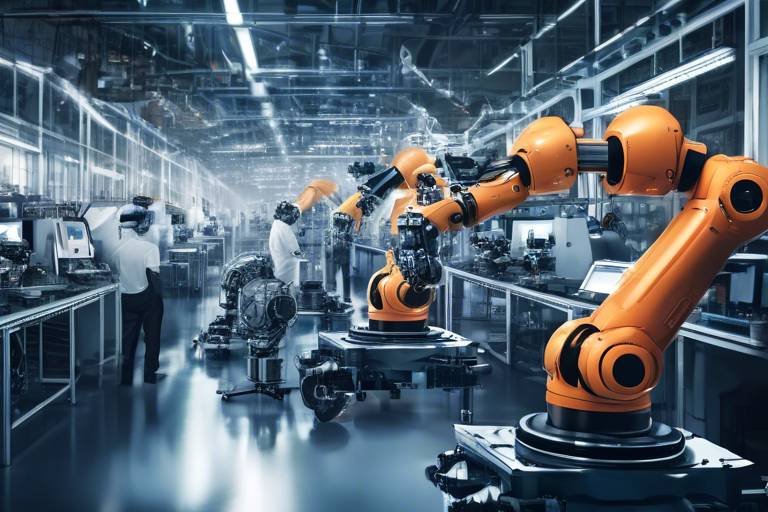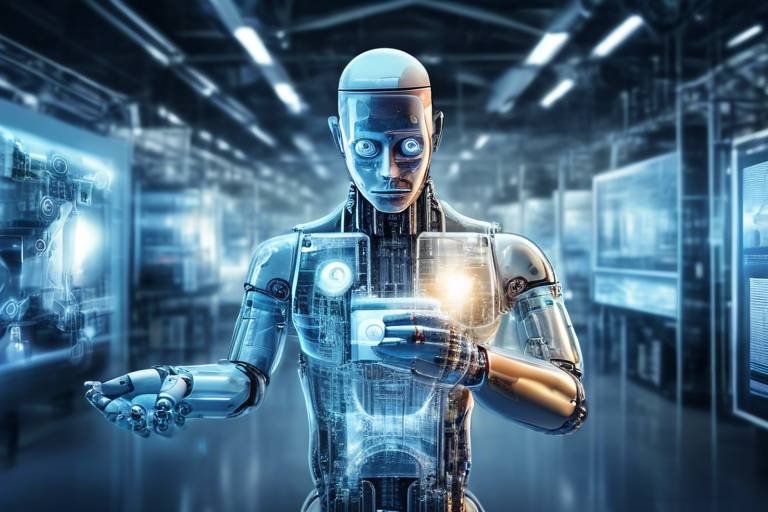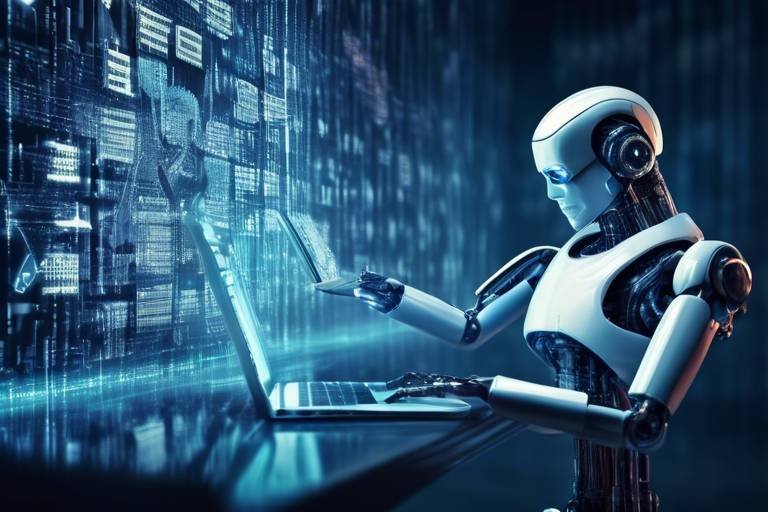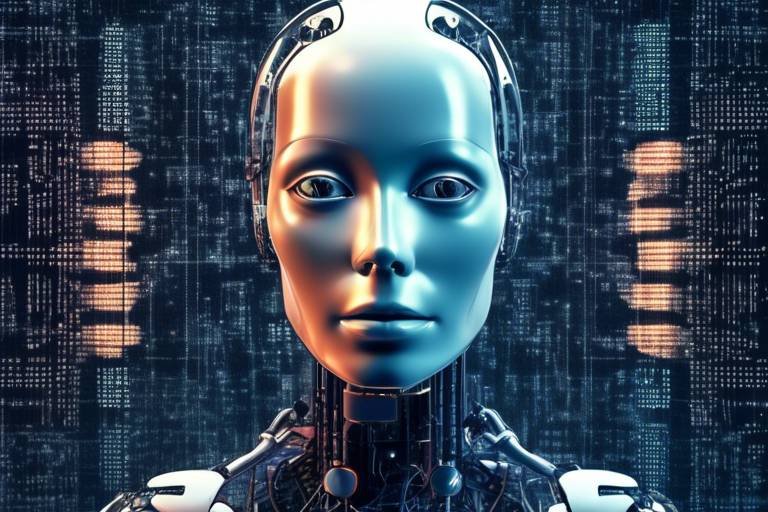How AI Innovations are Redefining Manufacturing
The manufacturing industry is undergoing a seismic shift, driven by the rapid advancements in artificial intelligence (AI). This transformation is not just a trend; it's a revolution that is reshaping the way products are made, enhancing efficiency and productivity like never before. Imagine a factory where machines can predict failures before they happen, where workflows are optimized in real-time, and where human workers collaborate seamlessly with intelligent systems. Sounds futuristic, right? But this is the reality we are stepping into.
At its core, AI is all about data. The manufacturing sector is rich with data generated from machines, sensors, and production lines. By harnessing this data, AI technologies can analyze patterns, predict outcomes, and make informed decisions that lead to improved operations. For instance, AI can identify inefficiencies in production processes, allowing manufacturers to minimize waste and maximize output. This level of precision not only boosts productivity but also reduces costs, enabling companies to remain competitive in a rapidly evolving market.
However, the integration of AI into manufacturing is not without its challenges. Companies often face hurdles such as the high costs of implementation, the need for skilled personnel, and the complexity of integrating new technologies with existing systems. These obstacles can seem daunting, but with the right strategies and a commitment to innovation, manufacturers can overcome them and reap the rewards of AI.
As we dive deeper into this topic, we'll explore how AI is revolutionizing production processes, the role of predictive maintenance, and the impact on the workforce. Buckle up, because the future of manufacturing is not just about machines; it's about the synergy between humans and technology.
Artificial intelligence is revolutionizing production by optimizing workflows, reducing waste, and increasing precision. This section examines how AI technologies streamline manufacturing operations and improve overall productivity. In the manufacturing world, time is money. By leveraging AI, manufacturers can automate repetitive tasks, allowing human workers to focus on more complex and creative aspects of production. This not only enhances job satisfaction but also drives innovation.
Moreover, AI systems can analyze vast amounts of data from various stages of production, identifying bottlenecks and suggesting improvements. For example, consider a car manufacturing plant where AI monitors the assembly line in real-time. If a particular machine is running slower than usual, AI can alert operators to investigate and rectify the issue before it escalates into a larger problem. This proactive approach significantly reduces downtime and keeps the production line moving smoothly.
Predictive maintenance powered by AI helps manufacturers anticipate equipment failures before they occur. This section discusses the benefits of predictive analytics in reducing downtime and maintenance costs. Imagine a scenario where a factory's machinery can communicate its health status, alerting technicians about potential issues long before they lead to a breakdown. That's the power of predictive maintenance.
Effective data collection is crucial for predictive maintenance. Here, we explore various techniques and technologies that enable manufacturers to gather and analyze data for better decision-making. These techniques include:
- Sensor Technology: IoT sensors can monitor equipment performance in real-time, providing valuable insights into operational efficiency.
- Cloud Computing: Storing data in the cloud allows for easy access and analysis, enabling manufacturers to make informed decisions quickly.
- Data Analytics Tools: Advanced analytics can sift through large datasets to find patterns that humans might overlook.
The Internet of Things (IoT) plays a significant role in data collection. This subsection discusses how IoT devices contribute to real-time monitoring and data-driven insights in manufacturing. By connecting machines and systems, IoT creates a network where data flows freely, enabling manufacturers to make swift and informed decisions. For instance, a factory can track energy usage across different machines, identifying which ones consume more energy than necessary and optimizing their usage accordingly.
Machine learning algorithms are essential for analyzing collected data. This subsection delves into how these algorithms enhance predictive maintenance strategies and improve operational efficiency. These algorithms learn from historical data, allowing them to make predictions about future equipment behavior. By continuously improving their accuracy, they help manufacturers stay one step ahead, ensuring that machinery operates at peak performance.
Despite the benefits, implementing AI in manufacturing comes with challenges. This section highlights common obstacles manufacturers face and strategies to overcome them. For example, the initial investment in AI technology can be significant, and many manufacturers may hesitate to take the plunge. However, by starting small—perhaps with pilot projects—companies can gradually scale their AI initiatives, proving their value over time.
AI innovations are changing the workforce landscape in manufacturing. This section explores the implications for job roles, skills required, and the importance of reskilling employees. As machines take over repetitive tasks, the demand for skilled workers who can manage and collaborate with AI systems is on the rise. This shift means that employees will need to adapt, and companies must invest in training programs to ensure their workforce is equipped for the future.
To adapt to AI technologies, manufacturers must invest in skill development. This subsection discusses effective training programs that prepare workers for the evolving industry demands. Training programs could include:
- Technical Skills: Courses on AI, machine learning, and data analytics.
- Soft Skills: Emphasizing teamwork and communication to foster collaboration between humans and AI.
- Continuous Learning: Encouraging a culture of lifelong learning to keep pace with technological advancements.
The future of manufacturing lies in the collaboration between humans and AI. This subsection examines how effective teamwork can enhance productivity and innovation in the workplace. Rather than viewing AI as a replacement for human workers, manufacturers should see it as a partner. By combining human creativity and problem-solving abilities with AI's analytical power, companies can drive innovation and achieve unprecedented levels of productivity.
Q: How does AI improve productivity in manufacturing?
A: AI improves productivity by automating repetitive tasks, optimizing workflows, and providing real-time insights that help manufacturers make informed decisions.
Q: What is predictive maintenance?
A: Predictive maintenance uses AI and data analytics to anticipate equipment failures before they occur, allowing manufacturers to reduce downtime and maintenance costs.
Q: What skills are needed for the future manufacturing workforce?
A: The future workforce will need technical skills related to AI and data analytics, as well as soft skills like teamwork and communication to collaborate effectively with AI systems.

AI in Production Processes
Artificial intelligence is not just a buzzword; it’s a game-changer in the manufacturing sector. Imagine a factory floor where machines communicate seamlessly, production lines adjust automatically, and human workers are empowered with real-time data. This isn’t science fiction; it’s the reality of AI in production processes today. By leveraging advanced algorithms and data analytics, manufacturers can optimize workflows, reduce waste, and enhance precision like never before.
One of the most significant ways AI is transforming production is through workflow optimization. Traditional manufacturing processes often involve a lot of manual intervention, which can lead to inefficiencies. With AI, manufacturers can automate various tasks, allowing for smoother operations. For instance, AI systems can analyze production data in real-time and adjust machinery settings to maintain optimal performance. This not only speeds up the production cycle but also minimizes the risk of human error.
Moreover, AI technologies are instrumental in waste reduction. By analyzing data from previous production runs, AI can identify patterns that lead to material waste. For example, if a particular machine consistently produces defective items, AI can flag this issue for immediate attention, enabling manufacturers to rectify the problem before it escalates. This proactive approach not only saves money but also contributes to sustainability efforts by minimizing environmental impact.
Another area where AI shines is in enhancing precision. In manufacturing, even a minor deviation in measurements can lead to significant issues down the line. AI systems utilize machine learning algorithms to ensure that every component is produced with pinpoint accuracy. For instance, in industries like aerospace or automotive, where specifications are extremely tight, AI can monitor and control processes to ensure compliance with stringent quality standards.
To illustrate the impact of AI in production processes, let’s consider the following table that outlines key benefits:
| Benefit | Description |
|---|---|
| Workflow Optimization | Automates tasks and adjusts processes in real-time for efficiency. |
| Waste Reduction | Identifies patterns to minimize material waste and improve sustainability. |
| Enhanced Precision | Ensures compliance with quality standards through accurate measurements. |
In summary, the integration of AI into production processes is revolutionizing the way manufacturers operate. It’s not just about making things faster; it’s about making them smarter. As we continue to embrace these technologies, the future of manufacturing looks not only more efficient but also more innovative.

Predictive Maintenance
is a game changer in the manufacturing industry, leveraging the power of artificial intelligence to foresee equipment failures before they become critical issues. Imagine a world where machines tell you when they need a check-up, much like how your car alerts you when it's time for an oil change. This proactive approach not only minimizes unexpected downtimes but also significantly reduces maintenance costs, allowing manufacturers to operate more efficiently.
At the heart of predictive maintenance lies predictive analytics, which uses historical data and real-time information to predict future equipment behavior. This process involves collecting vast amounts of data from various sources, including machinery sensors, operational logs, and maintenance records. By analyzing this data, manufacturers can identify patterns and anomalies that indicate potential failures. For instance, if a machine's vibration levels spike beyond a certain threshold, it could signal an impending breakdown. By addressing these issues early, companies can avoid costly production halts and extend the lifespan of their equipment.
Moreover, the benefits of predictive maintenance extend beyond just saving money. It enhances overall productivity by ensuring that machines are operating at peak performance. When equipment runs smoothly, it leads to consistent product quality and faster production times, which are vital in today’s competitive market. In fact, a study by McKinsey & Company found that companies implementing predictive maintenance strategies can reduce maintenance costs by up to 30% and improve equipment uptime by as much as 20%.
Effective data collection is crucial for the success of predictive maintenance. Manufacturers use a variety of techniques to gather the necessary data, which can include:
- Sensor Technology: Sensors installed on machinery collect real-time data on various operational parameters, such as temperature, vibration, and pressure.
- Automated Monitoring Systems: These systems continuously monitor equipment performance and send alerts when anomalies are detected.
- Historical Data Analysis: Analyzing past maintenance records helps in understanding failure patterns and predicting future issues.
By employing these techniques, manufacturers can create a comprehensive data ecosystem that supports informed decision-making. However, simply collecting data is not enough; it must be effectively analyzed to yield actionable insights.
The Internet of Things (IoT) plays a significant role in data collection for predictive maintenance. IoT devices, such as smart sensors and connected machinery, enable real-time monitoring of equipment health. Imagine a factory where every machine is connected to a central system, providing instant feedback on its performance. This connectivity allows manufacturers to track equipment conditions continuously, making it easier to spot potential issues before they escalate.
Another crucial element in predictive maintenance is the use of machine learning algorithms. These algorithms analyze the data collected from various sources to identify trends and predict failures. By learning from historical data, machine learning models can improve their accuracy over time, making them invaluable in the predictive maintenance toolkit. For example, if a particular type of machine has a history of failing under specific conditions, the algorithm can flag similar conditions in real time, prompting maintenance teams to take action before a breakdown occurs.
In summary, predictive maintenance not only enhances operational efficiency but also transforms how manufacturers approach equipment management. By leveraging AI technologies, companies can transition from a reactive maintenance approach to a proactive one, ultimately leading to a more resilient and productive manufacturing environment.
Q1: What is predictive maintenance?
A1: Predictive maintenance is a proactive maintenance strategy that uses data analysis and AI to predict equipment failures before they occur, allowing for timely interventions.
Q2: How does predictive maintenance save costs?
A2: By anticipating equipment failures, manufacturers can reduce unexpected downtimes and maintenance costs, leading to significant savings in operational expenses.
Q3: What role does IoT play in predictive maintenance?
A3: IoT devices enable real-time monitoring of machinery, providing valuable data that helps in predicting potential equipment issues.
Q4: Can predictive maintenance improve product quality?
A4: Yes, by ensuring that machines are operating correctly, predictive maintenance helps maintain consistent production quality and efficiency.

Data Collection Techniques
In the realm of predictive maintenance, effective data collection techniques are paramount. These techniques not only help manufacturers gather essential information but also enable them to make informed decisions that can significantly reduce downtime and maintenance costs. Imagine a symphony orchestra; each instrument must play its part harmoniously to create beautiful music. Similarly, data collection techniques must work together to provide a comprehensive view of manufacturing operations.
One of the most prominent techniques in data collection is the use of sensor technologies. Sensors can measure various parameters such as temperature, vibration, and pressure in real-time. These devices act like the eyes and ears of the manufacturing process, constantly monitoring equipment performance. For instance, a vibration sensor can detect anomalies in machinery, alerting operators to potential problems before they escalate into costly failures.
Another vital technique involves data analytics platforms. These platforms aggregate data from multiple sources, providing a centralized hub for analysis. By employing advanced analytics, manufacturers can identify trends and patterns that might otherwise go unnoticed. This is akin to having a detective on the case, piecing together clues to solve a mystery. With the right tools, manufacturers can uncover insights that lead to better decision-making and optimized operations.
Moreover, the integration of the Internet of Things (IoT) has revolutionized data collection in manufacturing. IoT devices can communicate with each other and share data seamlessly. For example, a smart thermostat in a production facility can adjust the temperature based on real-time data from other IoT devices, ensuring optimal conditions for machinery and products alike. This interconnectedness allows for a more agile and responsive manufacturing environment.
To illustrate the impact of these data collection techniques, consider the following table that highlights key methods and their benefits:
| Data Collection Technique | Benefits |
|---|---|
| Sensor Technologies | Real-time monitoring, early fault detection |
| Data Analytics Platforms | Centralized data analysis, trend identification |
| IoT Integration | Seamless data sharing, responsive adjustments |
In conclusion, the combination of sensor technologies, data analytics platforms, and IoT integration creates a robust framework for data collection in manufacturing. By harnessing these techniques, manufacturers can not only anticipate equipment failures but also enhance overall operational efficiency. It's like having a crystal ball that allows companies to foresee potential issues and address them proactively, ultimately leading to a more resilient and productive manufacturing environment.

IoT Integration
The integration of the Internet of Things (IoT) into manufacturing processes is nothing short of a game changer. Imagine a factory where machines talk to each other, sharing real-time data that helps optimize production and reduce waste. With IoT devices embedded in machinery, manufacturers can gather a wealth of data that drives informed decision-making. These devices monitor everything from temperature and humidity to machine performance and energy consumption, creating a digital ecosystem that enhances operational efficiency.
One of the standout features of IoT integration is its ability to enable real-time monitoring. For instance, sensors placed on equipment can detect anomalies that may indicate potential failures. This proactive approach allows manufacturers to address issues before they escalate, ensuring smoother operations and minimizing downtime. The benefits don't stop there; IoT integration also facilitates better inventory management. By tracking inventory levels in real-time, companies can reduce excess stock and avoid shortages, leading to a more streamlined supply chain.
Moreover, the data collected through IoT devices can be analyzed to uncover patterns and insights that were previously hidden. For example, manufacturers can identify trends in machinery performance over time, allowing them to make data-driven decisions about maintenance schedules and operational adjustments. This not only enhances productivity but also contributes to significant cost savings.
However, the journey to successful IoT integration is not without its challenges. Manufacturers must ensure that their systems are secure and that the data being collected is accurate and reliable. As IoT devices become more prevalent, the risk of cyber threats increases, making it crucial for companies to invest in robust cybersecurity measures. Additionally, integrating IoT with existing systems can be complex, requiring careful planning and execution.
In summary, IoT integration is reshaping the manufacturing landscape by providing unprecedented visibility into operations. As manufacturers embrace this technology, they are not only improving efficiency but also setting the stage for future innovations. The combination of IoT and AI creates a powerful synergy that will drive the next wave of advancements in the industry.
- What is IoT in manufacturing?
IoT in manufacturing refers to the network of connected devices that collect and exchange data to improve operational efficiency and decision-making.
- How does IoT enhance productivity?
By enabling real-time monitoring and data analysis, IoT helps manufacturers identify inefficiencies and optimize processes, leading to increased productivity.
- What are the challenges of IoT integration?
Challenges include ensuring data security, integrating with existing systems, and maintaining the reliability of data collected from IoT devices.

Machine Learning Algorithms
In the ever-evolving world of manufacturing, are becoming the backbone of predictive maintenance strategies. These algorithms are designed to analyze vast amounts of data collected from various sensors and devices across the production floor. By doing so, they can identify patterns and trends that human analysts might overlook. Imagine having a crystal ball that not only tells you what might go wrong with your machines but also when it's likely to happen. That's the power of machine learning!
One of the standout features of machine learning is its ability to learn from data. As more data is fed into the system, the algorithms improve their accuracy over time. This process is akin to training a pet; the more consistent and comprehensive the training, the better the outcomes. In manufacturing, this means that the more operational data you have, the better your predictive maintenance will be. For instance, a machine learning model can predict a failure in a conveyor belt by analyzing historical data on its performance, including vibrations, temperature fluctuations, and operational hours.
Moreover, machine learning algorithms can be classified into several categories, each serving unique purposes in manufacturing:
- Supervised Learning: This involves training the model on a labeled dataset, where the outcomes are known. For example, a manufacturer can use historical failure data to train the model to predict future failures.
- Unsupervised Learning: Here, the algorithm identifies patterns in data without prior labels. It's useful for anomaly detection, helping manufacturers spot irregularities in machine behavior that could indicate potential issues.
- Reinforcement Learning: This type of learning involves algorithms that learn optimal actions through trial and error, which can be particularly useful in optimizing complex manufacturing processes.
Furthermore, the integration of machine learning with other technologies, such as the Internet of Things (IoT), enhances its effectiveness. IoT devices continuously collect data from machines, feeding it into machine learning models for real-time analysis. This synergy allows manufacturers to not only predict failures but also implement timely interventions, drastically reducing downtime and maintenance costs.
However, implementing machine learning algorithms is not without its challenges. Manufacturers must ensure that they have the right infrastructure to support data collection and analysis. This includes investing in high-quality sensors, robust data storage solutions, and powerful computing resources. Additionally, the algorithms require continuous tuning and validation to ensure they remain effective as operating conditions change.
In conclusion, machine learning algorithms are reshaping the landscape of predictive maintenance in manufacturing. By harnessing the power of data, these algorithms provide manufacturers with a competitive edge, enabling them to anticipate failures and optimize their operations like never before.
- What are machine learning algorithms?
Machine learning algorithms are computational methods that enable systems to learn from data, identify patterns, and make predictions without explicit programming. - How do machine learning algorithms benefit manufacturing?
They help in predicting equipment failures, optimizing maintenance schedules, and enhancing overall operational efficiency. - What types of machine learning are used in manufacturing?
Supervised learning, unsupervised learning, and reinforcement learning are commonly used types in the manufacturing sector. - Do I need special hardware for machine learning?
Yes, implementing machine learning often requires robust computing resources and infrastructure to handle large datasets effectively.

Challenges in Implementation
As the manufacturing sector embraces the wave of artificial intelligence, it's essential to recognize that the journey is not without its challenges. While AI has the potential to revolutionize production lines and enhance efficiency, manufacturers often face significant hurdles during implementation. One of the primary challenges is the integration of new technologies into existing systems. Many manufacturing plants operate on legacy systems that may not be compatible with advanced AI solutions. This can lead to increased costs and extended timelines as businesses attempt to bridge the gap between old and new technologies.
Moreover, the skills gap poses another formidable challenge. As AI technologies evolve, the demand for skilled workers who can operate and maintain these systems grows. Unfortunately, many employees may lack the necessary training or expertise, resulting in a workforce that is ill-prepared for the future. Companies must invest in upskilling and reskilling programs to ensure their employees can adapt to these new technologies. Without this investment, businesses risk falling behind competitors who have successfully navigated these transitions.
Another significant obstacle is the data quality and availability. AI systems rely heavily on data for training and operation. If the data collected is inaccurate, incomplete, or inconsistent, it can lead to poor decision-making and ineffective AI applications. Manufacturers need to establish robust data governance policies to ensure that the data used for AI algorithms is of high quality. This often involves implementing new data collection techniques and investing in data management systems.
Additionally, the cost of implementation can be daunting. While the long-term benefits of AI are clear, the initial investment required for technology, training, and infrastructure can be substantial. Many manufacturers may hesitate to commit to these costs, especially if they are uncertain about the return on investment (ROI). To mitigate this concern, businesses should conduct thorough analyses to project potential savings and productivity gains from AI integration.
Lastly, there is the challenge of cultural resistance within organizations. Change can be intimidating, and employees may feel threatened by the introduction of AI technologies, fearing job displacement or a shift in their roles. It is crucial for manufacturers to foster a culture of adaptability and openness to change. By engaging employees in the AI transition process, addressing their concerns, and highlighting the benefits of collaboration between humans and machines, companies can cultivate a more positive attitude towards AI.
In summary, while the implementation of AI in manufacturing presents numerous challenges, understanding these hurdles is the first step towards overcoming them. By focusing on integration, skills development, data quality, cost management, and cultural acceptance, manufacturers can successfully navigate the complexities of adopting AI technologies and reap the rewards of enhanced efficiency and productivity.
- What are the main challenges of implementing AI in manufacturing?
The main challenges include technology integration, skills gaps, data quality, cost of implementation, and cultural resistance within organizations.
- How can manufacturers overcome the skills gap?
Manufacturers can invest in upskilling and reskilling programs to prepare their workforce for AI technologies.
- Why is data quality important for AI?
Data quality is crucial because AI systems rely on accurate and consistent data to make effective decisions and predictions.
- What can companies do to manage the costs of AI implementation?
Companies should conduct thorough analyses to project potential savings and productivity gains, helping to justify the initial investment.
- How can organizations address cultural resistance to AI?
Organizations can foster a culture of adaptability by engaging employees in the AI transition process and addressing their concerns.

Impact on Workforce
The integration of artificial intelligence in the manufacturing sector is not just about machines and algorithms; it profoundly affects the workforce as well. As AI technologies become more prevalent, they are reshaping job roles, altering skill requirements, and prompting a significant shift in how employees interact with technology. Imagine walking into a factory where robots and humans work side by side, each complementing the other's strengths—this is the new reality of manufacturing.
One of the most significant changes brought about by AI is the transformation of job roles. Traditional tasks that once required manual labor are increasingly being automated. This raises an important question: what happens to the workers whose jobs are replaced by machines? While some roles may become obsolete, new opportunities are emerging that demand a different set of skills. For instance, positions in data analysis, AI programming, and machine maintenance are on the rise. Workers will need to adapt to these changes, and this is where the importance of reskilling comes into play.
To ensure that employees are equipped for the future, manufacturers must invest in skill development programs. These programs should focus on teaching workers how to operate, maintain, and collaborate with AI systems. Training could include:
- Hands-on workshops with AI tools
- Online courses in data science and analytics
- Certification programs for AI and machine learning
Moreover, the collaboration between humans and AI is not just beneficial but essential for the future of manufacturing. When humans and machines work together, the potential for innovation skyrockets. For example, AI can handle repetitive tasks, allowing human workers to focus on more complex, creative problem-solving. This synergy can lead to increased productivity and a more engaging work environment.
However, this shift is not without its challenges. There may be resistance from employees who feel threatened by the rise of AI or fear job loss. It is crucial for manufacturers to foster a culture of collaboration and trust. Open communication about how AI will be integrated into workflows and how it can enhance rather than replace human roles can help alleviate these concerns.
In conclusion, the impact of AI on the workforce in manufacturing is multifaceted. While it presents challenges, it also offers exciting opportunities for growth and development. By embracing these changes and investing in education and training, manufacturers can ensure that their workforce is not only prepared for the future but also empowered to thrive in it.
- Will AI replace all manufacturing jobs? While AI will automate certain tasks, it will also create new roles that require different skills.
- How can workers prepare for the changes brought by AI? Workers can engage in reskilling programs focused on technology and data analysis to adapt to new job requirements.
- What skills will be most important in the AI-driven manufacturing sector? Skills in data analysis, AI programming, and machine maintenance will be increasingly valuable.

Skill Development Programs
As the manufacturing landscape shifts with the integration of artificial intelligence, have become essential for ensuring that employees are equipped to navigate this new terrain. These programs are not just about keeping up with technology; they are about empowering workers to thrive in an AI-driven environment. Imagine a factory where every worker is not only aware of the latest technologies but also skilled in using them to enhance productivity and quality. This vision is achievable through comprehensive training initiatives.
To effectively prepare employees for the challenges and opportunities presented by AI, manufacturers must focus on several key areas:
- Technical Skills: Training programs should cover essential technical skills, including data analysis, machine learning basics, and familiarity with AI tools. This knowledge allows workers to understand and leverage AI technologies effectively.
- Soft Skills: In addition to technical expertise, soft skills such as problem-solving, critical thinking, and communication are vital. These skills enable employees to collaborate effectively with AI systems and their human counterparts.
- Continuous Learning: The rapid pace of technological advancement means that training cannot be a one-time event. Manufacturers should foster a culture of continuous learning, encouraging employees to seek out new knowledge and skills regularly.
Moreover, manufacturers can adopt various formats for their skill development programs, such as:
| Training Format | Description |
|---|---|
| On-the-Job Training | Employees learn by doing, gaining hands-on experience with AI tools and technologies while performing their regular tasks. |
| Workshops and Seminars | Short-term sessions that focus on specific skills or technologies, often led by industry experts. |
| Online Courses | Flexible, self-paced learning options that allow employees to study at their convenience, covering a wide range of topics. |
By investing in these skill development programs, manufacturers not only enhance their workforce's capabilities but also foster a sense of ownership and engagement among employees. When workers feel supported in their professional growth, they are more likely to embrace the changes brought about by AI and contribute positively to the company's goals. Ultimately, this investment in human capital is a crucial step towards creating a resilient and adaptive workforce that can thrive in the age of artificial intelligence.
Q1: Why are skill development programs important in manufacturing?
A1: Skill development programs are crucial because they equip employees with the necessary skills to work alongside advanced technologies, ensuring they remain relevant and productive in an evolving industry.
Q2: What types of skills should be focused on in training programs?
A2: Training programs should focus on both technical skills, like data analysis and AI tool usage, and soft skills, such as communication and problem-solving, to foster effective collaboration.
Q3: How can manufacturers encourage continuous learning?
A3: Manufacturers can encourage continuous learning by creating a culture that values ongoing education, offering resources for self-study, and providing access to workshops and online courses.

Collaboration Between Humans and AI
In the rapidly evolving landscape of manufacturing, the collaboration between humans and artificial intelligence is becoming increasingly vital. Imagine a factory floor where human intuition meets the analytical prowess of AI; it’s like having a seasoned chef who knows how to blend flavors perfectly, supported by a high-tech kitchen that ensures every ingredient is measured with precision. This partnership not only enhances productivity but also fosters innovation in ways that were previously unimaginable.
One of the most exciting aspects of this collaboration is the ability to leverage the unique strengths of both humans and AI. While AI excels at processing vast amounts of data and identifying patterns that might escape human notice, humans bring creativity, empathy, and critical thinking to the table. This combination allows for a more dynamic work environment where decisions are informed by data but still guided by human insight.
Furthermore, the integration of AI into manufacturing processes can significantly reduce the burden of repetitive tasks on human workers. For instance, AI systems can take over mundane activities such as inventory management or quality control checks, allowing human employees to focus on more complex and rewarding tasks. This shift not only boosts morale but also enhances job satisfaction, as workers are able to engage in more meaningful work.
However, successful collaboration requires a cultural shift within organizations. Companies must foster an environment where employees feel comfortable working alongside AI technologies. This involves not only investing in training programs that educate workers on how to use AI tools effectively but also promoting a mindset that values collaboration over competition. Here are some key strategies for fostering this collaborative spirit:
- Encourage Open Communication: Establish channels for feedback and discussion about AI tools and their impact on work processes.
- Provide Continuous Learning Opportunities: Offer workshops and training sessions that empower employees to enhance their skills in conjunction with AI technologies.
- Highlight Success Stories: Share examples of successful human-AI collaborations within the organization to inspire and motivate the workforce.
As we look to the future, the potential for human-AI collaboration in manufacturing is immense. Companies that embrace this partnership will not only improve their operational efficiency but also drive innovation and creativity within their teams. It’s a shift from viewing AI as a threat to seeing it as an invaluable ally. By working together, humans and AI can create a manufacturing environment that is not only more efficient but also more adaptable to the ever-changing demands of the market.
In conclusion, the collaboration between humans and AI is not just a trend; it’s the future of manufacturing. By harnessing the strengths of both, businesses can navigate challenges and seize opportunities in a way that benefits everyone involved. So, let’s embrace this new era of teamwork and watch as the manufacturing landscape transforms before our eyes!
- What are the main benefits of human-AI collaboration in manufacturing?
The main benefits include increased efficiency, reduced errors, enhanced job satisfaction, and greater innovation as humans focus on creative problem-solving while AI handles data analysis.
- How can companies prepare their workforce for collaboration with AI?
Companies can prepare their workforce by investing in training programs, promoting a culture of continuous learning, and encouraging open communication about AI tools and their applications.
- Will AI replace human jobs in manufacturing?
While AI may automate certain tasks, it is more likely to augment human roles, allowing workers to focus on higher-level responsibilities that require creativity and critical thinking.
Frequently Asked Questions
- What is the role of AI in manufacturing?
AI plays a crucial role in manufacturing by optimizing production processes, enhancing efficiency, and reducing waste. It helps streamline operations through automation and data analysis, which leads to improved productivity and precision in manufacturing tasks.
- How does predictive maintenance work?
Predictive maintenance uses AI to analyze data from machinery and equipment to predict when maintenance should be performed. By anticipating failures before they occur, manufacturers can reduce downtime and maintenance costs, ensuring smoother operations.
- What technologies are used for data collection in predictive maintenance?
Data collection techniques for predictive maintenance include IoT devices, sensors, and machine learning algorithms. These technologies gather real-time data about equipment performance, which is then analyzed to make informed maintenance decisions.
- What challenges do manufacturers face when implementing AI?
Common challenges include high initial costs, resistance to change among employees, and the need for skilled personnel to manage AI systems. Manufacturers must develop strategies to address these obstacles to successfully integrate AI into their operations.
- How is the workforce impacted by AI innovations?
AI innovations are transforming job roles in manufacturing, requiring workers to adapt to new technologies. This shift emphasizes the importance of reskilling and upskilling employees to equip them with the necessary skills to thrive in an AI-driven environment.
- What are effective skill development programs for workers?
Effective skill development programs include hands-on training, online courses, and workshops focused on AI technologies and data analysis. These programs help workers gain the skills needed to operate alongside AI systems and enhance their productivity.
- How can humans and AI collaborate in manufacturing?
Collaboration between humans and AI can enhance productivity by combining human creativity and decision-making with AI's data processing and efficiency. This teamwork can lead to innovative solutions and improved operational outcomes in the manufacturing sector.



















